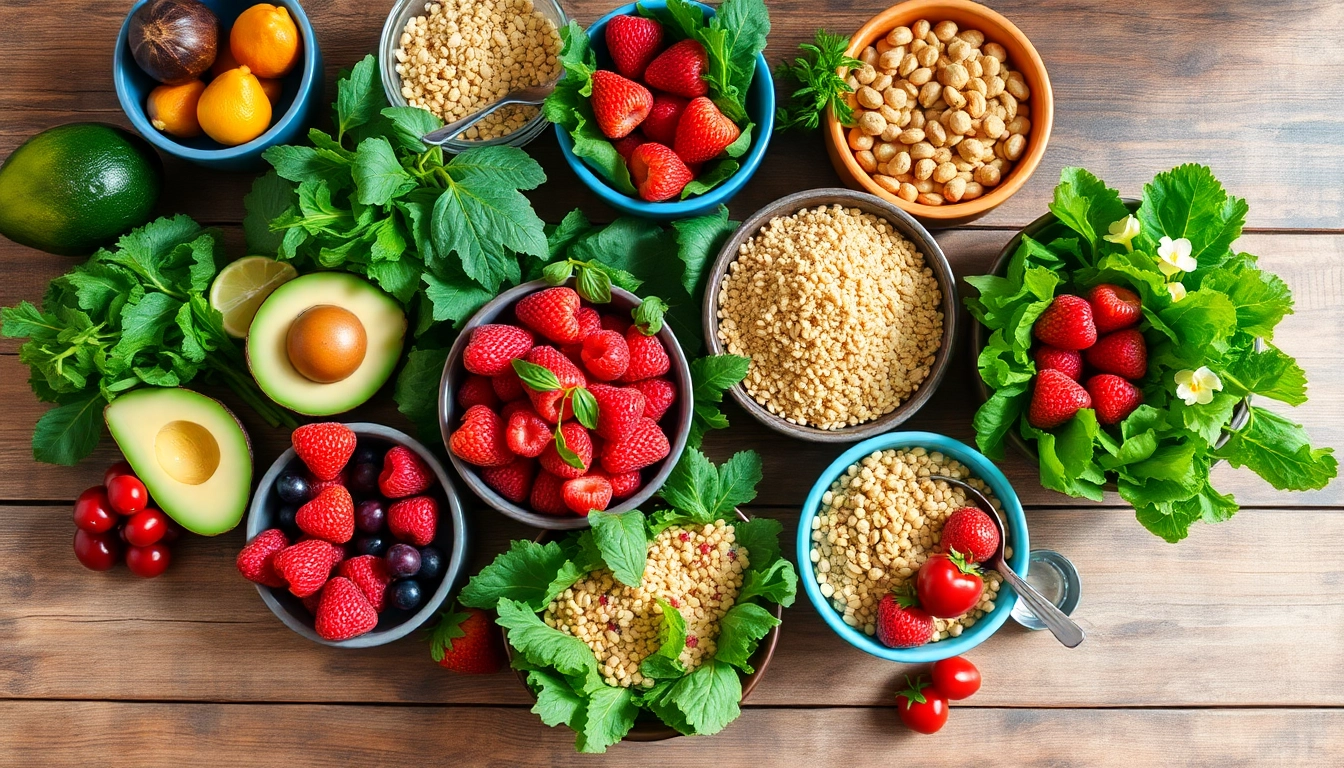Introduction to Healthy Food
In a world where fast food and dietary fads seem to dominate the culinary landscape, understanding the essence of healthy food is more critical than ever. Healthy food isn’t just about eating less; it’s about incorporating more of what nourishes our bodies and supports our overall well-being. This guide aims to delve deeply into what constitutes healthy food, its benefits, and practical ways to incorporate it into your lifestyle.
What Constitutes Healthy Food?
Healthy food can be defined as items that have a significant positive impact on your health. Generally, it includes:
- Fruits and Vegetables: Rich in vitamins, minerals, fibers, and antioxidants, these are essential for bodily functions.
- Whole Grains: Foods such as brown rice, quinoa, and oats provide more nutrients and fiber than refined grains.
- Lean Proteins: Sources like chicken breast, fish, legumes, and nuts supply the necessary amino acids without excessive saturated fat.
- Healthy Fats: Avocados, olive oil, and fatty fish contain essential fatty acids beneficial for heart health.
Importance of Nutrition in Everyday Life
Nutrition plays a foundational role in our lives. It influences not only physical health but also mental and emotional well-being. A diet rich in healthy food can:
- Enhance energy levels and reduce fatigue.
- Boost the immune system, making the body more resilient against diseases.
- Support mental health by reducing symptoms of depression and anxiety.
- Improve digestion and manage weight effectively.
Common Misconceptions About Healthy Eating
Despite the wealth of information available, several misconceptions about healthy eating persist. Here are a few:
- Healthy food is boring: Many assume that healthy eating means bland and unappealing meals. However, healthy food can be delicious and diverse.
- All fats are bad: While trans fats and excessive saturated fats are harmful, healthy fats are essential for optimal health.
- Healthy eating is expensive: Although some health foods can be pricey, many affordable options provide excellent nutritional value.
Top Healthy Foods to Incorporate into Your Diet
Fruits and Vegetables That Boost Health
To maximize health benefits, aim to fill half your plate with fruits and vegetables at every meal. Some of the most nutritious options include:
- Spinach: High in iron, vitamin K, and various antioxidants, spinach is a powerhouse veggie.
- Blueberries: Known for their high levels of antioxidants, blueberries can boost heart health and improve brain function.
- Broccoli: Rich in fiber, vitamins C and K, and several minerals, broccoli is excellent for digestion and bone health.
- Avocados: These creamy fruits are loaded with healthy fats, potassium, and vitamins E and C, promoting heart health and reducing inflammation.
Whole Grains and Their Benefits
Whole grains are an essential part of a balanced diet. Unlike refined grains, they retain their bran and germ, which are rich in nutrients. The key benefits include:
- Improved digestive health through higher fiber content.
- Reduced risk of heart disease and diabetes.
- Weight management due to higher satiety levels.
Some easy-to-incorporate whole grains are:
- Quinoa
- Brown rice
- Whole grain bread
- Oats
Lean Proteins and Their Role in Nutrition
Protein is crucial for building and repairing tissues. Lean protein sources are low in saturated fat and include:
- Chicken Breast: One of the best lean protein sources, it is versatile and low in fat.
- Fish: Fatty fish like salmon provide omega-3 fatty acids, essential for brain and heart health.
- Legumes: Beans, lentils, and peas are excellent plant-based protein options that also provide fiber.
- Nuts and Seeds: Almonds, chia seeds, and flaxseeds are rich in protein and healthy fats.
How to Plan Meals with Healthy Food
Creating Balanced Meals for Optimal Nutrition
Balanced meals are vital for maintaining health and energy. A balanced meal typically consists of protein, healthy fats, and carbohydrates. Try the following tips for meal planning:
- Utilize the Healthy Eating Plate model to visualize portions for each major food group.
- Incorporate a variety of food colors on your plate to ensure diverse nutrient intake.
- Limit processed foods high in salt, sugar, and unhealthy fats.
Meal Prep Tips for Busy Lifestyles
Meal prepping can save time and make healthy eating easier. Here are some effective strategies:
- Batch cook staples like brown rice, quinoa, and beans at the start of the week.
- Chop and store vegetables in clear containers so they are easy to grab and use.
- Plan recipes ahead and create grocery lists to minimize impulse buys of unhealthy options.
Understanding Portion Control and Serving Sizes
Understanding portion control is crucial to prevent overeating. Consider these strategies:
- Use smaller plates to trick your brain into thinking you’re eating more.
- Follow recommended serving sizes as noted on food packages.
- Listen to your body’s hunger signals, eating only when hungry and stopping when satisfied.
Healthy Food Recipes for Every Meal
Quick Breakfast Ideas Packed with Nutrients
Start your day with nutritious options that are quick to prepare. Some ideas include:
- Overnight Oats: Mix oats, yogurt, and your favorite fruits the night before for a hassle-free breakfast.
- Avocado Toast: Spread mashed avocado on whole grain bread and top with a poached egg for extra protein.
- Smoothies: Blend fruits, leafy greens, and a source of protein such as nut butter or Greek yogurt.
Easy Lunch Options for a Balanced Diet
Keep lunches healthy yet satisfying. Consider these options:
- Quinoa Salad: Combine quinoa with diced vegetables, chickpeas, and a lemon-olive oil dressing.
- Whole Grain Wrap: Fill a wrap with turkey, spinach, tomatoes, and hummus for a delicious meal.
- Lentil Soup: Packed with protein and fiber, lentil soup is filling and easy to prepare in bulk.
Delicious Dinner Recipes That Prioritize Health
Dinners can be both healthy and delightful. Here are some easy recipes:
- Baked Salmon: Season salmon with herbs and bake it with asparagus for a healthy, flavorful dish.
- Stir-Fried Tofu: Toss tofu with colorful vegetables and a splash of low-sodium soy sauce over brown rice.
- Vegetable Pasta: Use whole grain or vegetable-based pasta with a homemade tomato sauce and fresh basil.
Staying Motivated and Overcoming Challenges
Setting Realistic Goals for Healthy Eating
Setting achievable and measurable goals is essential for success. Use the SMART criteria:
- Specific: Define what you want to achieve.
- Measurable: Ensure you can quantify progress.
- Achievable: Set goals that are realistic.
- Relevant: Align them with your personal values.
- Time-Bound: Set a timeline for achieving your goals.
Dealing with Cravings and Emotional Eating
Cravings can derail even the best intentions. Here are strategies to control them:
- Identify triggers: Keep a food journal to help pinpoint when and why cravings occur.
- Practice mindfulness: Techniques such as meditation can help manage emotional responses to food.
- Choose healthier alternatives: When cravings strike, opt for fruit, nuts, or low-calorie snacks instead of junk food.
Finding Support and Resources for Healthy Living
Having a support system can significantly impact your healthy eating journey. Consider the following:
- Join community groups or online forums focused on healthy food.
- Consult with a registered dietitian for personalized meal planning and advice.
- Engage friends or family members in your healthy eating goals for mutual support.



